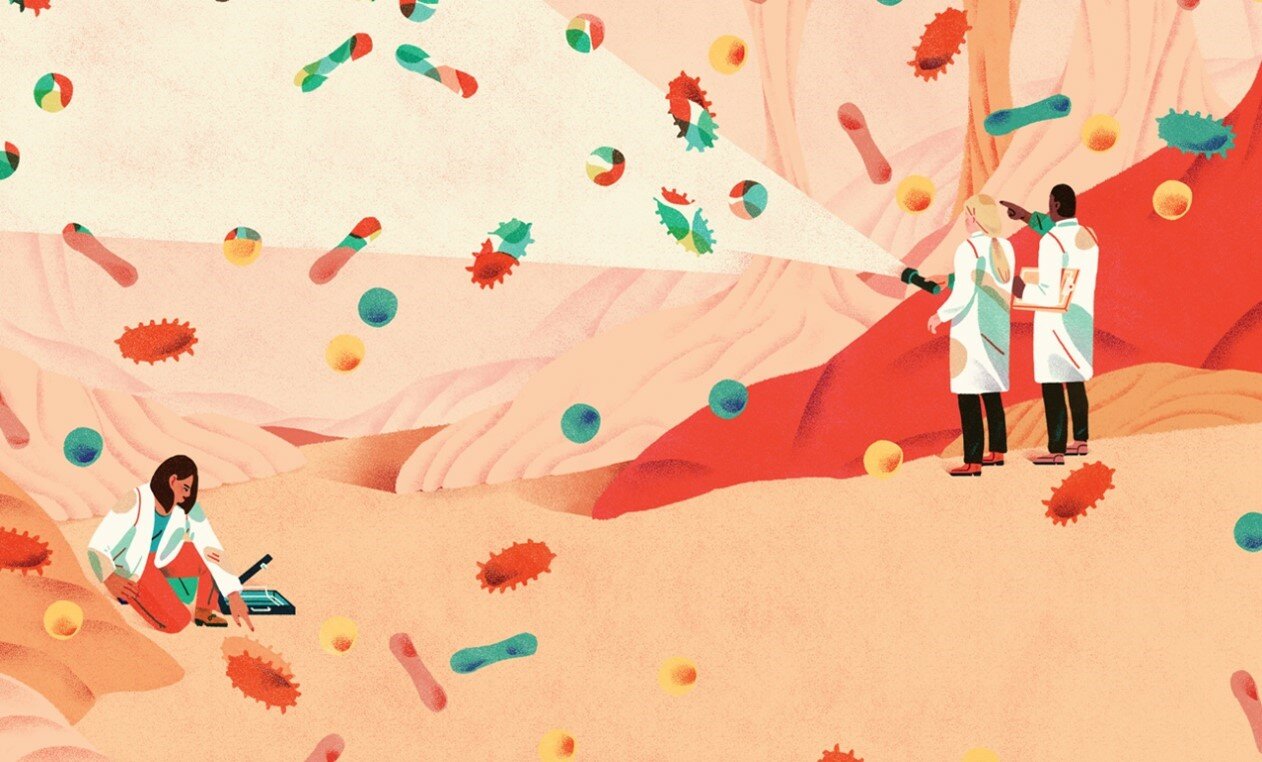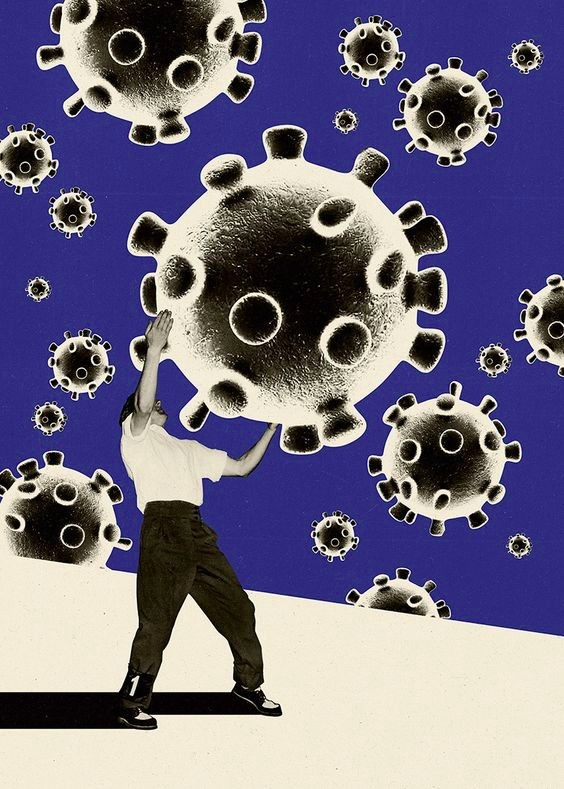Edited by Mohamed Wehbe
“When Orson Welles said “We’re born alone, we live alone, we die alone”, he was mistaken. Even when we are alone, we are never alone. We exist in symbiosis – a wonderful term that refers to different organisms living together. Some animals are colonized by microbes while they are still unfertilized eggs; others pick up their first partners at the moment of birth. We then proceed through our lives in their presence. When we eat, so do they. When we travel, they come along. When we die, they consume us. Every one of us is a zoo in our own right – a colony enclosed within a single body. A multi-species collective. An entire world.”
― Ed Yong, I Contain Multitudes: The Microbes Within Us and a Grander View of Life
When you first think of bacteria or viruses, what is the first thought that comes to your mind? For most of us, we usually associate microorganisms with being pathogens and causing dreadful diseases such as tuberculosis, meningitis, or even more recently, causing the ongoing COVID-19 pandemic. However, microorganisms are actually the driving force of our well-being. They’re the very reason I am able to write this article and you’re able to read it. Microorganisms living in our body outnumber our own cells and only 5 % of bacteria are actually pathogenic, meaning they cause diseases. We are composed of an entire minuscule ecosystem that harbors good bacteria which help in digesting our food and protecting us from pathogens. As Dr. Michael Specter beautifully said: “They congregate in our digestive systems and our mouths, fill the space between our teeth, cover our skin, and line our throats. We are inhabited by as many as ten thousand bacterial species; those cells outnumber those which we consider our own by ten to one, and weigh, all told, about three pounds–the same as our brain. Together, they are referred to as our microbiome.” However, it is not just our microbiome that is extremely important to our survival, scientists across many generations have utilized bacteria, fungi, and viruses to develop antibiotics and vaccines to prevent deadly diseases. In this article, I will explore the profound uses of microorganisms from helping us maintain our health to revolutionizing biotechnology, medicine, and potentially saving our environment. Through exploring how the positive impacts of microorganisms outweigh the negatives, we can begin to appreciate the crucial role they play in our everyday lives and how advancements in medicine and research would not have been possible without them.
The Gut Microbiome: An Ignored Organ
The gut microbiome has been an exciting subject that many researchers have been extensively exploring. The human gut microbiome is often termed as the “ignored organ” and it is made of bacteria, archaea, viruses, and eukaryotic organisms that significantly impact our physiology whether in health or in disease. A healthy adult human typically harbors more than 1000 species of bacteria belonging mainly to the Bacteroidetes and Firmicutes phyla. The gut microbiota plays an integral role in digestion as it can generate nutrients from substrates that are typically indigestible by the host. Because of this, humans were able to cultivate mutualistic relationships with such bacteria to help digest that are commonly found in dietary vegetables such as lettuce. By processing these indigestible dietary fibers, microbes generate short fatty acid chains which are a source of energy for our intestinal mucosa. They also synthesize vitamin K and folic acid which are otherwise not synthesized without their help. However, their role is not just restricted to aiding in digestion but they are also important for regulating immune responses and tumorigenesis in the gut. The microbiota helps in educating and training the immune response to respond to invading pathogens and tolerating the good bacteria by promoting the differentiation of regulatory T cells. The normal microbiota helps in the innate immune response by producing harmful toxins such as bacteriocins that would kill invading pathogens. For example, E.coli can produce colisins that would inhibit the growth of Salmonella and Shigella. Moreover, commensal bacteria such as Clostridium and B.fragilis also help in the adaptive immune response by inducing CD4+T cell differentiation into various types of T helper cells. In terms of tumorogenesis, probiotics and other gut resident bacteria are able to secrete molecules that can fight tumor growth and prevent gut tumorigenesis through various mechanisms. Microbiome research possesses great potential and its horizons are continuously expanding, leading to an increased understanding of the harmony that exists between the microorganisms in our bodies and our health.
Source: https://www.jeanniephan.com/illustration-editorial-reach-magazine-cover-microbes/
Bacterial Enzymes and Their Applications
In the 1960s, scientist noticed that bacteriophages (viruses that infect bacteria) had dramatic changes in their DNA as it was degraded and cut into many pieces. He discovered that bacteriophage-resistant bacteria develop a specific enzyme that only degrades the invading bacteriophage DNA and preserves its own DNA. This enzyme is known as a restriction enzyme and its discovery has led to researchers being able to manipulate, analyze, and create new combination sequences by cutting and pasting DNA. In fact, the fields of recombinant DNA technology, biotechnology, and genomics would not exist today if it wasn’t for the presence of restriction enzymes in bacteria. Its uses span from DNA cloning to paternity testing, forensics, genomics, and hereditary disease diagnosis. By using different restriction enzymes isolated from various bacteria, scientists are able to cut DNA at specific locations and then reattach the different sequences by using another enzyme called DNA ligase. Another extremely important bacterial enzyme that is the reason behind the PCR technology is . This enzyme was isolated from a heat-tolerant bacterium (Thermus aquaticus) that normally inhabits hot springs. The Polymerase Chain Reaction, also known as PCR, aims to amplify DNA fragments to diagnose genetic diseases or to detect viral infections. It is a three-step process that involves denaturation of the DNA (separation of its two strands), annealing of the primers, and the addition of nucleotides by an enzyme called and then the cycle repeats. During these three steps, the temperature alternates, and thus, the DNA polymerase must be able to withstand very high temperatures. As a result, since Taq polymerase is a heat-resistant DNA polymerase, it was able to overcome this limitation and ultimately become the reason behind our current PCR tests.
Microbial Cell Factories
Recombinant DNA technology, as noted earlier, has extensively used bacteria such as E.coli to produce various important proteins, most notably insulin. This is done by inserting a human gene that codes for insulin into a plasmid (loop of bacterial DNA) and then inserting the plasmid back into E.coli, turning it into a recombinant bacteria. The next step would be to place the recombinant bacteria into fermentation tanks and allow them to begin using the gene to produce human insulin. Insulin is then harvested from the bacteria and purified to be used as medicine for people suffering from diabetes for example. In this way, E.coli was able to act as a factory that can produce large quantities of insulin.
Antibiotics
We know that in order to eradicate bacterial infections, antibiotics are used. However, where do antibiotics exactly come from? Scientists have utilized bacteria and fungi to produce a vast range of antibiotics. One of such antibiotics is Penicillin which was first discovered by Alexander Fleming in 1929. He noted that the fungus Penicillium chrysogenum contaminated an agar plate that was streaked with a bacterium and produced an antibiotic against the bacteria, leading to its lysis. After Fleming, different scientists were able to purify penicillin from the fungus and ultimately used it to treat various bacterial infections. There is a wide variety of bacteria that naturally produce antibiotics to enhance their survival and these exact antimicrobial agents can be isolated and purified to treat various infectious diseases. An example of that would be Streptomycin which was obtained from a soil actinomycete (Streptomyces griseus) to treat a range of bacterial infections including tuberculosis and endocarditis. In fact, most antibiotics used in clinical medicine have been isolated from the species Streptomyces.
Source: https://slideplayer.com/slide/7290153/
Viral Vectors for Gene Therapy
Several viruses such as adenovirus, retrovirus, and herpes simplex virus have been modified to be used in gene therapy applications as viral vectors. Because of their capacity to efficiently penetrate cells and possibly obtain access to hard-to-reach, highly specialized cells, viruses serve as effective delivery vehicles. Viral vectors aim to deliver genetic material to a cell to manipulate it to express certain therapeutic genes. An example of that would be the viral vectors that have been used in COVID-19 vaccines. Such vaccines allow the delivery of a harmless form of the spike protein that is found on SARS-Cov-2 to trigger our immune system to produce antibodies. By tricking our cells into fighting what they think is a threat, our bodies have learned how to protect us in case we ever got exposed to the real virus. Viral vectors have also been extensively used in cancer gene therapies due to their high efficiency in delivering the genes that facilitate the production of therapeutic proteins.
Environmental Uses of Microorganisms
Aside from their clinical benefits, microorganisms have been used for environmental purposes to mitigate the effects of different forms of pollution. is a common method that utilizes microorganisms or microbial enzymes to detoxify contaminants found in the soil. It is a sustainable technology to clear up different pollutants from ecosystems since natural microorganisms such as bacteria and fungi can stabilize, degrade, or store soil contaminants. In addition, oil spills in oceans can be cleaned up by hydrocarbon-eating bacteria, like Alcanivorax borkumensis. Such microbes are able to sense hydrocarbons and move toward the source where they will begin to reproduce and flourish. By breaking down the oil, they consume hydrocarbons and then emit the greenhouse gas carbon dioxide. Microorganisms can also reduce plastic waste since they have specific enzymes that digest PET, a form of plastic. The environmental uses of microorganisms are extremely vast and current research is investigating their role in developing sustainable methods to combat pollution and climate change.
Source: https://ars.els-cdn.com/content/image/1-s2.0-S1018364721000239-gr1_lrg.jpg
Take-home Message By taking a look at the enormous benefits of microorganisms compared to their negative outcomes, we can begin to understand how unfair our categorization of microbes has been. We must shift our perspective and instead begin viewing microbes not as enemies that need to be eradicated but rather as organisms that we are forever living in symbiosis with. Life on Earth would have been impossible if it weren’t for microbes such as cyanobacteria (blue-green algae) that used photosynthesis to produce oxygen and carbohydrates. Despite the current COVID-19 pandemic and all the infectious diseases that we suffer from, it is important to realize that such horrendous impacts are due to the minority of microorganisms and not the majority. In fact, we are currently able to control pandemics and infectious diseases due to the diverse clinical benefits that microorganisms represent. The development of antibiotics, insulin, vaccines, disease-diagnostic tools, and bioremediation is all thanks to the minuscule organisms that we often fear or overlook. However, as Ed Yong noted in his book: “It’s the start of a new era, when people are finally ready to embrace the microbial world.”





